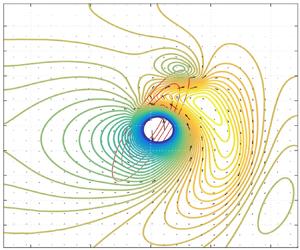Crossref Citations
This article has been cited by the following publications. This list is generated based on data provided by
Crossref.
Kurganov, Alexander
Liu, Yongle
and
Zeitlin, Vladimir
2021.
Interaction of tropical cyclone-like vortices with sea-surface temperature anomalies and topography in a simple shallow-water atmospheric model.
Physics of Fluids,
Vol. 33,
Issue. 10,
Zeitlin, Vladimir
2021.
Waves in Flows.
p.
93.
Rostami, Masoud
and
Zeitlin, Vladimir
2022.
Evolution of double-eye wall hurricanes and emergence of complex tripolar end states in moist-convective rotating shallow water model.
Physics of Fluids,
Vol. 34,
Issue. 6,
Rostami, Masoud
Zhao, Bowen
and
Petri, Stefan
2022.
On the genesis and dynamics of Madden–Julian oscillation‐like structure formed by equatorial adjustment of localized heating.
Quarterly Journal of the Royal Meteorological Society,
Vol. 148,
Issue. 749,
p.
3788.
Rostami, Masoud
and
Zeitlin, Vladimir
2022.
Instabilities of low-latitude easterly jets in the presence of moist convection and topography and related cyclogenesis, in a simple atmospheric model.
Geophysical & Astrophysical Fluid Dynamics,
Vol. 116,
Issue. 1,
p.
56.
Guo, Guizhen
Yin, Jie
Liu, Lulu
and
Wu, Shaohong
2024.
Quantitative Assessment of Typhoon Disaster Risk at County Level.
Journal of Marine Science and Engineering,
Vol. 12,
Issue. 9,
p.
1544.
Labban, Abdulhaleem H.
Hasanean, H. M.
Almahri, Ali
Al-Sakkaf, Ali Salem
and
Hussein, Mahmoud A. A.
2024.
Characterizing the Tropical Cyclones Activity over Arabian Sea (1982–2021).
Oceans,
Vol. 5,
Issue. 4,
p.
840.
Rostami, Masoud
Severino, Luca
Petri, Stefan
and
Hariri, Saeed
2024.
Dynamics of localized extreme heatwaves in the mid‐latitude atmosphere: A conceptual examination.
Atmospheric Science Letters,
Vol. 25,
Issue. 1,
Xu, Jin
Xue, Xinyue
Yang, Bo
Wang, Wen
Wu, Wenxiang
and
Ji, Xiaodong
2024.
Risk Assessment of Landfalling Tropical Cyclones in China Based on Hazard Risk Theory.
Applied Sciences,
Vol. 14,
Issue. 12,
p.
5126.
Vu, Dieu-Hong
Huang, Ching-Yuang
and
Nguyen, Thi-Chinh
2024.
Numerical Investigation of Track and Intensity Evolution of Typhoon Doksuri (2023).
Atmosphere,
Vol. 15,
Issue. 9,
p.
1105.
Cao, Yangyang
Kurganov, Alexander
Liu, Yongle
Rostami, Masoud
and
Zeitlin, Vladimir
2025.
On the dynamics of equatorial excited dipolar systems.
Physics of Fluids,
Vol. 37,
Issue. 5,
Saraceni, Miriam
Silvestri, Lorenzo
and
Bongioannini Cerlini, Paolina
2025.
Analyzing the Mediterranean Tropical-like Cyclone Ianos Using the Moist Static Energy Budget.
Atmosphere,
Vol. 16,
Issue. 5,
p.
562.
Vallis, Geoffrey K.
and
Oishi, Jeffrey S.
2025.
Moist geophysical fluid dynamics: idealised models for convection and circulation.
Geophysical & Astrophysical Fluid Dynamics,
Vol. 119,
Issue. 1,
p.
116.
Rostami, Masoud
Petri, Stefan
Fallah, Bijan
and
Fazel-Rastgar, Farahnaz
2025.
Aeolus 2.0's thermal rotating shallow water model: A new paradigm for simulating extreme heatwaves, westerly jet intensification, and more.
Physics of Fluids,
Vol. 37,
Issue. 1,
Hartney, Nell
Bendall, Thomas M.
and
Shipton, Jemma
2025.
Exploring forms of the moist shallow‐water equations using a new compatible finite‐element discretisation.
Quarterly Journal of the Royal Meteorological Society,

 $\beta$-plane at low latitudes. Instabilities of such TC-like vortices are studied first in the
$\beta$-plane at low latitudes. Instabilities of such TC-like vortices are studied first in the  $f$-plane approximation, and their development, interplay with beta-gyres and the role they play in vorticity redistribution and intensification are then analysed along the vortex trajectories on the
$f$-plane approximation, and their development, interplay with beta-gyres and the role they play in vorticity redistribution and intensification are then analysed along the vortex trajectories on the  $\beta$-plane, both in dry and moist-convective environments. Interactions of the vortices with an idealized topography in the form of zonal and meridional ridges and islands of elliptic form and the role of moist convection in these processes are then investigated, revealing rich vortex-dynamics patterns. The results can be helpful in crude analyses and predictions of the evolution of the barotropic component of TC, of their trajectories over the ocean and during landfall and of related condensation/precipitation patterns.
$\beta$-plane, both in dry and moist-convective environments. Interactions of the vortices with an idealized topography in the form of zonal and meridional ridges and islands of elliptic form and the role of moist convection in these processes are then investigated, revealing rich vortex-dynamics patterns. The results can be helpful in crude analyses and predictions of the evolution of the barotropic component of TC, of their trajectories over the ocean and during landfall and of related condensation/precipitation patterns.

